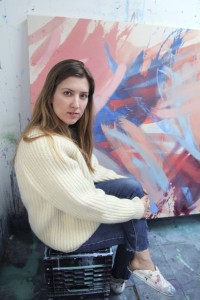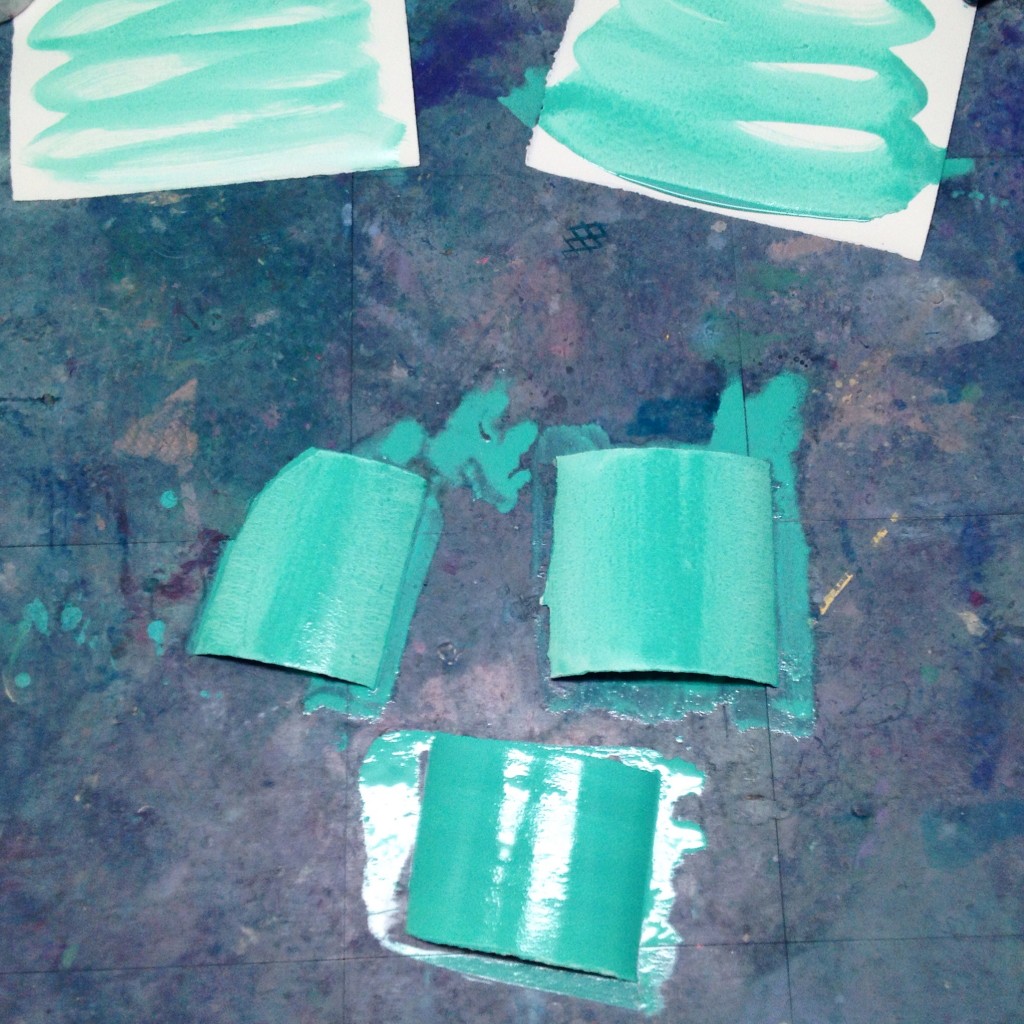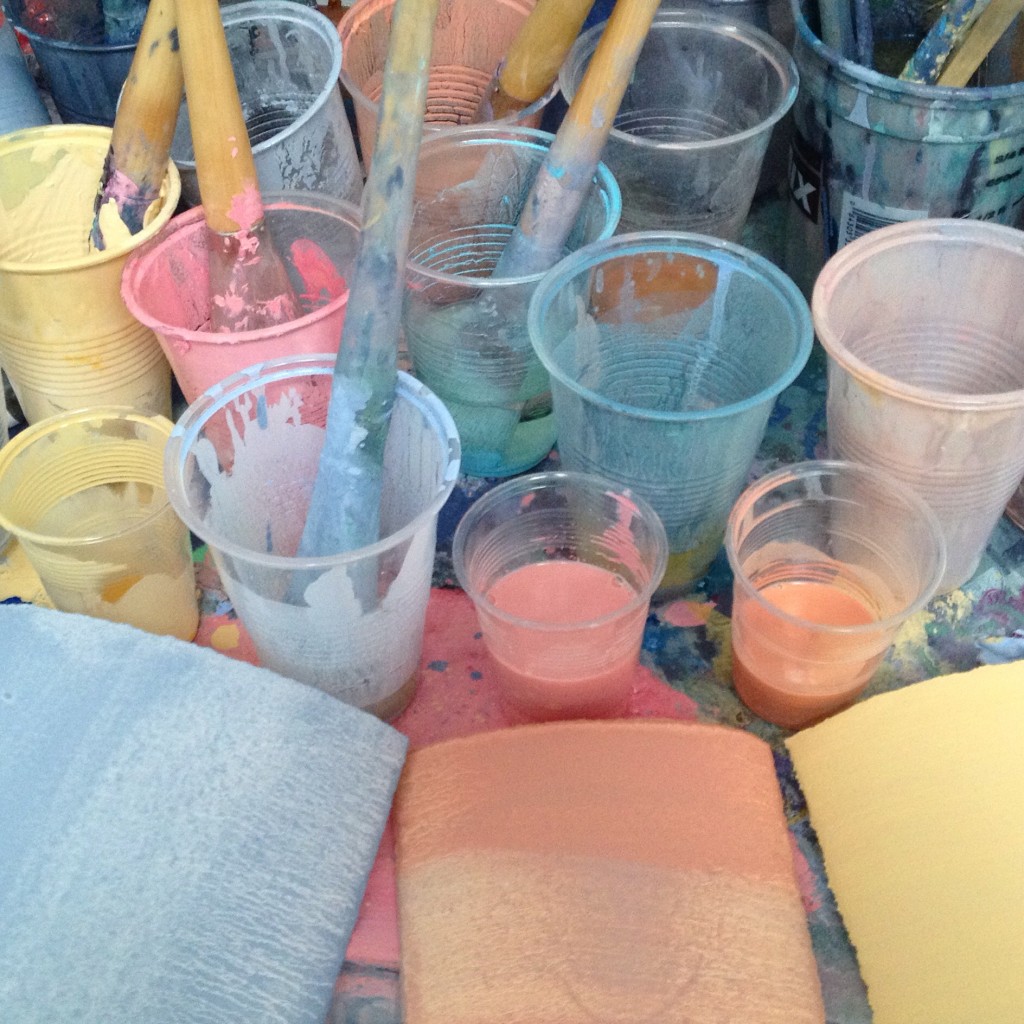Maren Miller asks Catherine Pearson about the new paintings in her show at Good Work Gallery and the launch of her book, A Feeling.
 M: Are we both going to transcribe and compare our own versions and see where we favored ourselves?
M: Are we both going to transcribe and compare our own versions and see where we favored ourselves?
C: I’m just gonna make stuff up.
Both: [Cheers]
M: So I’m curious – and I think we’ve talked about this before – where you draw the line between mark and shape. With recent work you refer to certain things in your paintings as marks but other things as shapes. Does that reflect a particular thought process or is it mainly intuitive?
C: It’s rudimentary in an almost “elementary school” way. Like a thing that’s just one line, that’s a mark, but a big fat thing that takes two or three gestures to make, that’s a shape.
M: But wouldn’t you call that squiggle mark a
shape?
C: I think you might! We had that really good chat in my studio recently where you liked one of the first squiggle paintings and you were said: that’s the first time the mark looks more like a shape….
M: But you still consider that a mark?
C: Yeah. A shapely mark.
M: You just want it both ways I guess.
C: It’s everything at the same time. Simultaneously. It contains multitudes.
inside the surface. i’m trying to create depth with very little compositionally. If there’s already the surface plane of the canvas and the pigment is inside the canvas that’s something I can play off of.
M: It’s interesting to talk about depth with paintings that are so much about surface. Rather than illusionism.
C: I do have that woodshop story from Cooper about how I went in to make some stretcher bars and the shop tech says “How big do you want them?” And I’m like, “54 by 54”. He asks, “But what about the third dimension?” and I’m like…
M: I’m trying to think back to the point at which you started allowing the the canvas to come through…
C: I like the kind of stain painting where the
“what do you mean? It’s a square.”
Both: (laughter)
C: He goes: “No, the other dimension”. And I say: “they have four sides you fool”. This went on for some time and finally I realized that he was talking about how far they come off the wall. And I realized this hadn’t even occurred to me. And I really didn’t care. Then the story was told back to me later by someone “I heard this crazy story in the shop today about this painter who didn’t know about the third dimension”…
M: (laughs) That’s so cool
C: I don’t know about the third dimension!
M: And I refuse to learn!
C: I refuse to engage with the third dimension!

M: Well the point is that you don’t think of them as objects. In any way.
C: No. I think of them as paintings.
M: So what does that mean? What is a painting then?
C: It’s just the surface. How much you can pack into just a surface. How much can you do with oil paint and a surface? These are the barest set of parameters I can work in, and since it’s abstract it can literally be anything that ever happened! It’s so open that it’s almost impossible to begin.That challenge has kept me super interested for a really long time. Now I finally want to make figurative painting and other things again because I feel like I got a little bit of a handle on what it meant to make work that way.
M: Do you draw a serious line for yourself between abstract and representational work? Because for me that’s really hard to do.
C: In my own way. Just in the sense that I became completely invested in, i would say, the classical idea of abstract painting. I really wanted to investigate it. I started from a very old-fashioned place and I felt like I had to work my way through all my interests to find out why I was interested in them. And to get them out of my system. So when I’m thinking about trying figurative work again I then want to work through all the kinds of figurative painting I like.
M: (Laughs) Which is a lot. You may have to take a different approach there.
C: But I think in the process of doing that I will find my own place in it…who knows if I’ll end up in a style that’s somewhere in the middle.
M: So when you say you have to enter into figurative painting in a traditional way, at what point are you gonna start? What are you considering traditional? Cause it’s easy to point to the beginning of abstract painting, but where are you going to decide is the beginning of figurative painting for you?

C: Like a figure, in a room, a person in a room…
M: But I mean are you going to try to…
C: Oh you mean am I gonna try to paint like Courbet or something?
M: Yeah!
C: No I think it’s the same way that I approached figuring out what I like about abstract painting.
M: You want to feel what it feels like to paint your favorite type of work?
C: Yeah. I wanna paint like Matisse and get all these beautiful floral fabrics and one of my beautiful friends and get her cleavage out and go to town. If you’re gonna be voluptuous about it, you can’t be slightly voluptuous.
M: I like what you said though about having to paint through all the work that you were interested in. I mean, I have a hard time connecting with a lot of the painters that you really connect with, so I’m just curious what that moment is. Is it like… you’re looking at this painting, thinking about their process, wanting to feel the feeling of knowing that this decision is the right decision?
C: So much of what interests me in general in looking at art, and that I respond to with respect and admiration, is when I’m looking at a painting, no matter what style it’s painted in, that this person meant to make this exact painting. Every brushstroke that’s in here, every compositional decision — they’re into it.
M: So these painters that get into their own worlds and have their own systems, that create a vocabulary for themselves?
C: And who are invested in learning by doing…Hopefully you’re thinking of painting as a lifelong practice. When you’re flipping through one of these big monographs, looking at someone like David Hockney who just tries a shit ton of stuff…everything he tries still has this touch that’s very unique to him. It’s playful and has a certain sense of color, whether he’s making those weird xerox prints from the 80s, or now he’s doing the iPad stuff. Every era of his work is about getting excited about a new tool, or a new interest.
M: Do you feel like you go through periods where you’re really excited about different kinds of marks? That’s how I would apply that to you.
C: Yea for sure, I did that first squiggle and I felt this is new, this is different, I can do lots of things with this. I can give it different senses of speed depending on how fast I’m making it, how carefully I’m placing it, how wet to how dry, it can have a lot of different moods. So I got super excited about it and I did it on 30 paintings. But now when I went to make work a few weeks ago I was like I fucking hate that squiggle I don’t want to put that on this painting. I need a different mark, I’m so over that mark, I never want to see that mark again. But I’m sure it will find its way back eventually. It’s like when you get really excited about a food and you eat it every day until one day you’re like god Nutella’s disgusting.
M: It’s also funny with that squiggle though, most of your work I can see what you’re saying about the layers going over and under but the squiggle is always set on top like a little squirt of icing.
C: I heard it described back to me as a punchline which I thought was an interesting way of putting it.
M: It’s very you.
C: For a while, I wasn’t in a place where I fully understood what I was doing. I wasn’t capable of making the kind of work I envisioned and I wasn’t getting the feedback I wanted. But when I started to make the squiggly mark someone said: I can tell your work is humorous. The consensus was that it’s goofy. And that was one of the first times where I was like yeah, my work is conveying my intentions! That felt nice. I had felt like people thought I was trying to be more serious and intense about abstract painting than I was just because I was working through all these serious phases. It took a while for the humor that I naturally feel to become visible in the work, but I’m glad that’s finally coming through. It’s important to me that they be a lil goofy. Cause it’s goofy, it’s goofy to make something like that, and I feel goofy when I make them. I’m a goofball.
M: It’s like you want to convey that feeling but you refuse to speak English. You want people to feel really specific things but you won’t do anything to let them know, it’s all an insinuation game.
C: I think thats the magical thing about abstract painting that keeps me so invested in it. You’re trying, in my experience, to convey something so specific, with a medium that is so vague, so every single choice has to be exact or you’ve failed. Which is the high stakes I was talking about that’s super exciting. If I want to do a painting that’s starting with the three colors of the builing that I saw this morning when the light was at a certain time but I’m also listening to Jonathan Richman and giggling to myself while making it then I want that all to be exactly in there somehow because those are are all very specific things.
M: But only in your special Catherine language that’s so subtle.
C: But I want you to look at the painting and be like I feel a sense of early morning goofiness…
M: But you are still so invested in your own vocabulary that you won’t give that to anybody. I mean I don’t know how you would do it but I can think of many ways that aren’t like the Catherine paintings I’ve seen. I’m not saying you have to write Jonathan Richman on your paintings but I can think of many ways that would be more direct, so it can’t just be about wanting people to feel that…
C: Yea, well it’s about taking something and filtering it through your own process. For me it’s more than just that specific experience.
M: I wanted to talk you about your use of color. It seems like you go through these palettes that you work with for periods of time. I’m curious where those come from. You’ll say something like, oh, I based this off what I saw in the morning… But that can’t be happening that often, because you go through these periods where you paint with the same colors over and over again!
C: Well I’ll see a combo somewhere, and it’ll be super interesting to me so I’ll use it directly in one painting. Then as I’m making that painting I’ll be like, what if it was a slight difference, what if this hue was warmer, what if this hue was cooler, and that will start me immediately into the next painting. And I’m usually working on 3 or 4 paintings in the studio at the same time and sharing the different colors between them. And trying all the different ways that I can make one or two colors I found work.
M: Can you define a color working?
C: Ooh. I guess when it strikes me as being exactly what I want it to be and in the vibration with the other colors in a way that feels precise and correct to me.
M: And that preciseness and correctness, is that embodying a particular feeling that you want to convey or embodying some sort of moment, or a mood of the painting?
C: All of the above?
M: Because I get the sense that you’re afraid of your colors becoming muddy. The colors, even though translucency and stains are used, are all very autonomous. You seem to be in love with individual colors and you don’t want them to mingle on the canvas other than one behind the other. Is that another function of trying to preserve this moment you had when you were struck by the moment of those colors being put together?
C: I think so. And I think it’s a desire to have every element of the work feel chosen, so that if I do choose to have one small corner or one specific mark or moment in the painting where the colors do bleed together that you see that and you notice it. Because I think that so much of the allure of painting is that juicy messiness but I want that to feel intentioned. So when I’m working through a painting I’ll be striving for that crispness and that autonomous color for most of it so when I get to a certain part of it and it’s a wet plane and I’m going into it wet and the brush is mixing the two together and making this unholy alliance that part sticks out to you as an intention. So I think it’s like a meaningful mess.
M: Will you reject a painting if it leaves the devised system of experimentation? Or do you find that you’re making decisions on the fly?
C: On the fly all the time. I never, or very rarely have a preconceived idea of what the painting is, just a general scheme of colors that are on my mind and go from there. And oftentimes that’ll completely change through the course of making it. The only time I’m rejecting is when it feels overworked, when it loses spontaneity. I like the thought, like with the layers we were talking about that are all suspended and autonomous, and also intersecting, that they coalesced and were captured at this specific moment. But that they could also dissolve again at the next moment. If it’s overworked that sense of a briefly captured composition is lost.
M: Well you’re clearly invested in painting as a time based thing. You’re inserted in the moment of touching it, how long it takes to pull across it, the existing time as something like: I put this mark here first because it’s in the canvas.
C: I had a really good studio visit that kind of made me laugh but also cry a million years ago with this super anal guy who made every painting over 6 months, photorealist rendered things, and I had tried something new where I had done about 50 tiny pencil lines across the whole canvas or something, and I was like “this one is special because it took so long to make it, it took a whole day”
Both: [laughing]
C: And he was like “if you think that’s a painting that takes a long time then you’re a fucking insane person. You’re a very fast painter, so own it and get to know it but calm down”.
M: Yeah that’s really funny. It took a whole day.
C: It took a whole day to make that whole mark.
M: Should we go?
C: Lets go.